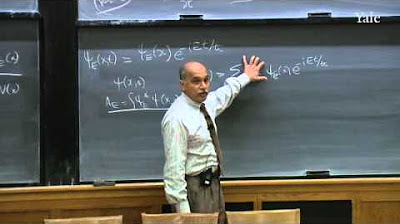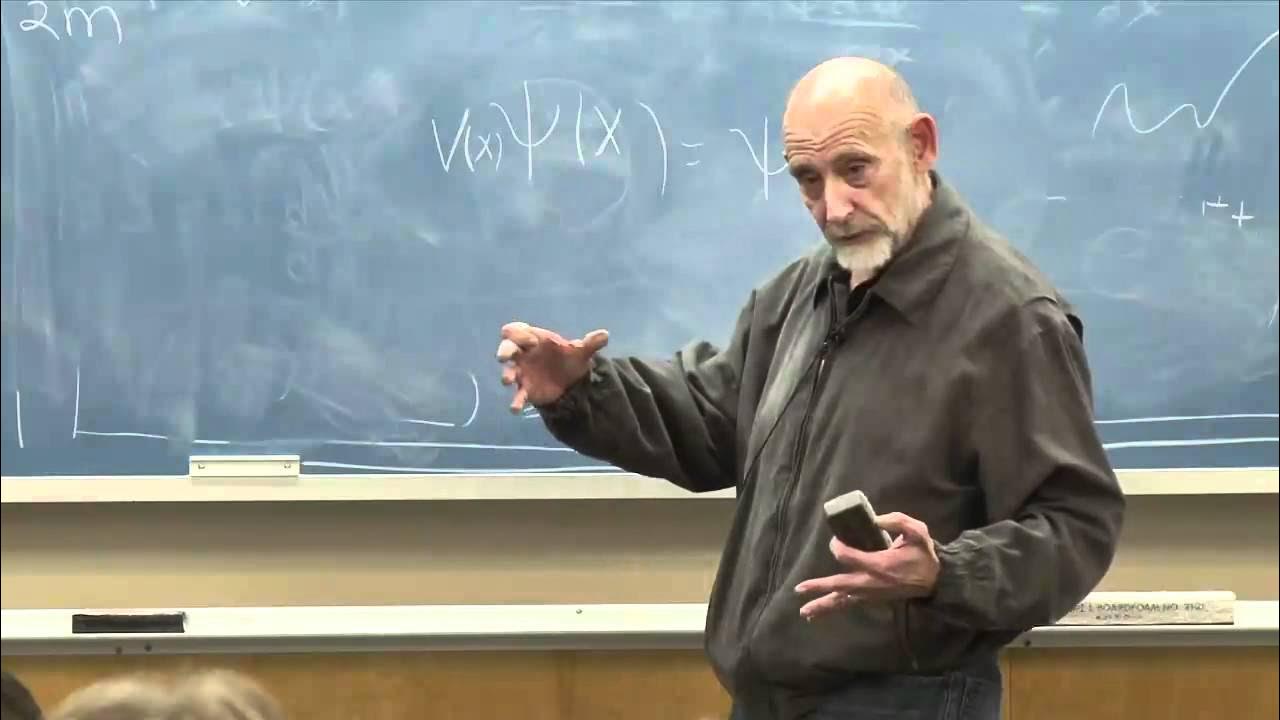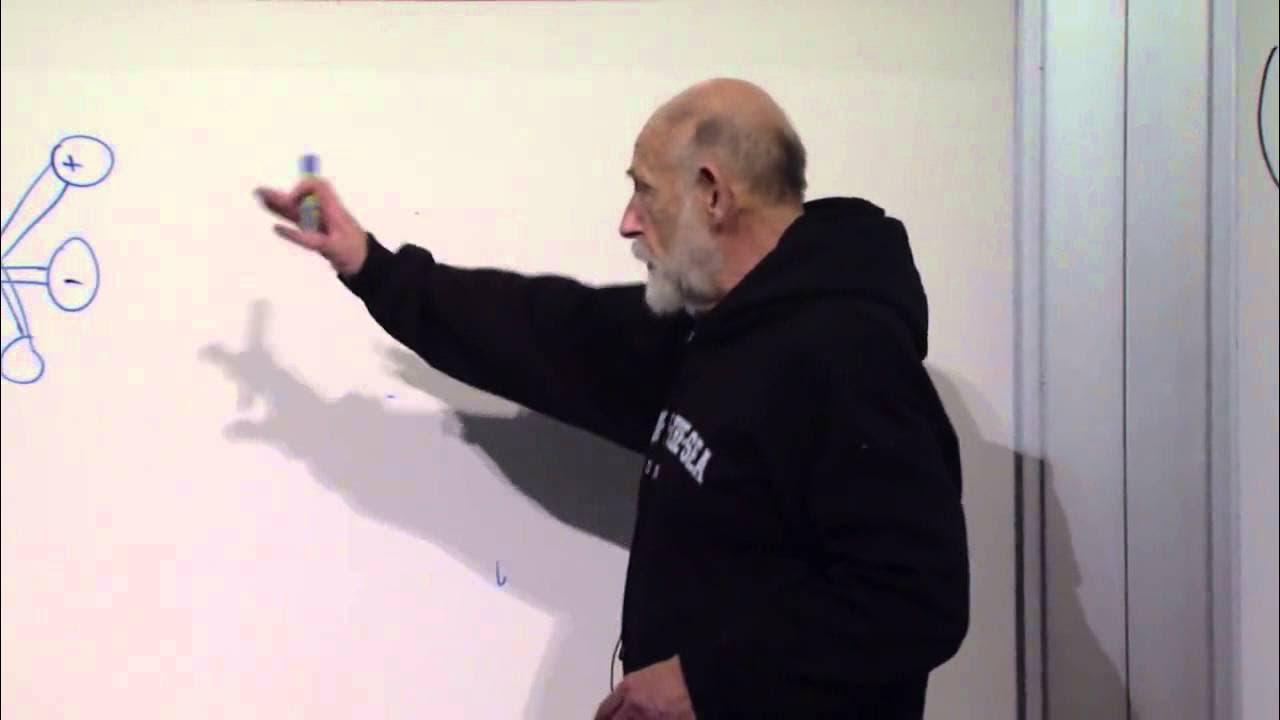Lecture 5 | New Revolutions in Particle Physics: Basic Concepts
TLDRThe transcript appears to be a lecture on quantum mechanics, focusing on the concepts of group and phase velocities in wave mechanics, the behavior of fermions and bosons, and an introduction to the Dirac equation. The lecturer discusses how group velocity is significant for signal transmission and particle movement, contrasting it with phase velocity, which is less relevant for quantum mechanics. The Pauli Exclusion Principle is highlighted, noting that fermions cannot share the same quantum state, leading to the unique behavior of electrons in atoms and the formation of a Fermi sphere. The lecture touches on the implications of negative energy states and how Dirac's hypothesis led to the concept of antiparticles. The summary of this lecture would provide a clear insight into the foundational concepts of quantum field theory and the distinctive properties of fermions and bosons, as well as a teaser into the complexities of the Dirac equation.
Takeaways
- 🌌 The concept of phase velocity in quantum mechanics is not directly related to measurable properties, whereas group velocity is associated with the actual movement of particles and signals.
- 🌉 For a plane wave, the phase velocity is determined by the wave's frequency (ω) and wave number (k), and is given by ω/k, which is the ratio of the wavelength to the period of oscillation.
- 🚀 In the context of Schrodinger waves, ω (energy) and k (momentum) are connected, and the group velocity is derived from the derivative of ω with respect to k, resulting in k/m for a non-relativistic particle.
- 🔧 Adding a constant to the frequency of every wave in a quantum system does not change the physical properties of the system, as only energy differences are significant.
- ✨ The physical quantities of interest in quantum mechanics, such as probability density and expectation values, involve the product of the wave function and its complex conjugate, which remains unchanged by a constant phase shift.
- ⚛️ Fermions, unlike bosons, cannot share the same quantum state due to the Pauli Exclusion Principle, which is a fundamental difference between these two types of particles.
- 📈 Fermions fill a momentum space in a pattern known as the Fermi sphere, where no two fermions can have the same quantum state, leading to a higher energy state compared to a corresponding system of bosons.
- 🔵 The ground state of a fermion system, such as electrons in a metal, is characterized by filling all available negative energy states up to the Fermi level, which is the boundary of the Fermi sphere.
- ➿ The Dirac equation, even in its simplest form, suggests the existence of antiparticles, where a 'hole' in the filled negative energy states can be considered as a particle of positive charge, leading to the concept of particle-antiparticle pairs.
- 🛠️ The mathematics of creation and annihilation operators for fermions involves anti-commutators, as opposed to commutators for bosons, which enforces the restriction that no two fermions can occupy the same state.
- ⚡ High-energy photons can interact with the Fermi Sea by ejecting electrons from deep within, while low-energy photons can only interact with electrons near the surface, creating particle-hole pairs.
Q & A
What is the difference between phase velocity and group velocity?
-Phase velocity is the speed at which the individual wave crests or troughs propagate, which is not directly related to the motion of particles or energy in quantum mechanics. Group velocity, on the other hand, is the speed at which the overall shape of the wave packet or the modulation (envelope) of a wave train propagates, which corresponds to the actual speed of signal transmission or particle movement.
Why is group velocity more significant than phase velocity in the context of quantum mechanics?
-Group velocity is more significant because it represents the actual speed at which quantum particles move and signals are transmitted. It is associated with the propagation of physical quantities such as probability density and expectation values, which are essential for understanding quantum phenomena.
How does the phase velocity of a wave relate to its frequency and wave number?
-For a plane wave, the phase velocity (v_phase) is given by the ratio of the angular frequency (ω) to the wave number (k), which is v_phase = ω/k. This relationship indicates that the phase velocity is the rate at which a particular phase of the wave propagates through space.
What is the significance of the Schrodinger equation in the context of wave-particle duality?
-The Schrodinger equation is a fundamental equation in quantum mechanics that describes how the quantum state of a physical system changes over time. It is significant because it provides a mathematical framework for understanding wave-particle duality, where particles such as electrons exhibit both wave-like and particle-like properties.
How does the addition of a constant to the frequency of every wave affect the phase velocity?
-Adding a constant to the frequency of every wave results in an additional term in the phase velocity calculation. However, this does not have a physical impact on the system because it corresponds to adding a constant to the energy of a particle, which does not affect energy differences and thus does not change any measurable physical properties.
What is the relationship between energy and momentum in the context of the Schrodinger wave?
-In the context of the Schrodinger wave, the energy (ω) is related to the momentum (k) through the equation ω² = k² / (2m), where m is the mass of the particle. This relationship arises from the energy-momentum dispersion relation for a relativistic particle, with h-bar (the reduced Planck constant) and c (the speed of light) set to 1 for simplicity in the given context.
What is the role of destructive interference in creating a localized wave packet?
-Destructive interference plays a crucial role in shaping a wave packet by ensuring that multiple plane waves with slightly different frequencies and phases combine in such a way that they cancel each other out in certain regions of space while reinforcing each other in others. This results in a concentrated 'lump' or packet of wave activity that can be considered a localized entity.
How does the concept of fermions relate to the Pauli Exclusion Principle?
-The concept of fermions is directly related to the Pauli Exclusion Principle, which states that no two fermions can occupy the same quantum state simultaneously. Fermions, which include particles like electrons, protons, and neutrons, are the building blocks of matter and their behavior is governed by this principle, leading to the discrete energy levels observed in atoms and the structure of the periodic table.
What is the difference between bosons and fermions in terms of their ability to occupy quantum states?
-Bosons can occupy the same quantum state simultaneously, which allows them to form a Bose-Einstein condensate where many bosons share the same quantum state. This is in contrast to fermions, which obey the Pauli Exclusion Principle and cannot share the same quantum state. Fermions, such as electrons, must occupy different states, which is why they are arranged in distinct energy levels around the nucleus of an atom.
What is the Fermi sphere, and how does it relate to the behavior of electrons in a system?
-The Fermi sphere is a conceptual model used in quantum mechanics to describe the distribution of fermions, such as electrons, in a system. It represents the highest energy state that electrons can occupy at absolute zero temperature. The Fermi sphere is characterized by a boundary in momentum space, beyond which no electrons can exist at zero temperature. This concept is crucial for understanding the behavior of electrons in materials, particularly in metals and semiconductors.
How does the Dirac equation provide a theoretical framework for the existence of antiparticles?
-The Dirac equation, a relativistic wave equation, allowed for the possibility of negative energy solutions. To resolve this issue, Dirac proposed that all negative energy states are filled, which is known as the Dirac sea. When a negative energy electron is removed from this sea, it leaves behind a 'hole' that behaves like a particle with positive energy and positive charge, essentially predicting the existence of the positron, the antiparticle of the electron. This was a major step in the understanding of antimatter.
Outlines
🌌 Introduction to Wave Velocities
The paragraph introduces the concepts of phase and group velocities in the context of wave motion. It emphasizes that phase velocity, while related to the wave's phase, does not correspond to any physical property in quantum mechanics. In contrast, group velocity is crucial as it represents the speed at which signals and particles move. The discussion uses the example of a plane wave to illustrate how these velocities are determined, highlighting the mathematical relationship between frequency (ω), wave number (k), and their ratio, which defines the phase velocity. The paragraph also touches on the connection between energy (ω) and momentum (k) in Schrödinger waves.
🚀 Effect of Adding a Constant to Wave Frequency
This section explores what happens when a constant is added to the frequency of every wave in a system. It is explained that such an addition alters the phase velocity but does not affect the physical properties of the system, as energy differences, not absolute values, are what matter. The paragraph uses the example of the Schrödinger equation and shows that adding a constant to the phase of a wave merely introduces a time-dependent phase factor, which does not affect measurable quantities such as probability density or expectation values.
🌐 Constructive Interference and Wave Packets
The paragraph delves into the concept of wave packets formed by the superposition of multiple plane waves. It describes how constructive interference leads to the creation of a localized wave packet, which moves at the group velocity. The group velocity is calculated by considering the derivative of the angular frequency with respect to the wave number, illustrating that it is the velocity at which the energy of the wave packet propagates. The discussion also clarifies that the group velocity is not affected by an arbitrary constant added to the frequency of the waves.
📐 Relativistic Wave Analysis
This part of the script examines the relationship between energy and momentum for a relativistic particle and how it affects the phase and group velocities of the corresponding wave. It is shown that for a massless particle (like a photon), the phase and group velocities are equal and are equal to the speed of light. However, for particles with mass, the phase velocity exceeds the speed of light, while the group velocity remains less than the speed of light. The product of the two velocities equals the speed of light, a consequence of the relativistic nature of the particle.
🚨 Quantum Mechanics and Physical Propagation
The paragraph discusses the implications of the mathematical treatment of waves in quantum mechanics. It is noted that an additive shift in the angular frequency does not have a physical effect, emphasizing that the phase velocity is generally irrelevant to the actual propagation of signals or energy flow. Instead, the group velocity is the significant factor, as it pertains to the motion of the wave and the propagation of quantum mechanical probability flow.
🔍 Momentum Conservation in Quantum Field Theory
The script touches on the principle of momentum conservation in quantum field theory. It uses an example of a particle decaying into two to illustrate how the conservation law arises from the integration over space. The paragraph explains that if a process can occur anywhere in space with equal probability, momentum will be conserved, leading to a delta function that enforces this conservation when the spatial integration is performed over the amplitude for a process.
🎓 Symmetries and Conservation Laws
The final paragraph reviews the connection between symmetries and conservation laws in quantum mechanics. It explains how the conservation of electric charge is related to the symmetry of the wave function under a phase change. The paragraph also distinguishes between fermions and bosons, noting that fermions cannot share the same quantum state due to the Pauli exclusion principle. The discussion sets the stage for a deeper exploration into fermions, which are particles that obey this exclusion principle.
Mindmap
Keywords
💡Phase Velocity
💡Group Velocity
💡Wave Packet
💡Destructive Interference
💡Schrodinger Equation
💡Momentum Conservation
💡Energy Conservation
💡Pauli Exclusion Principle
💡Fermions
💡Bosons
💡Dirac Equation
Highlights
Discussion on the difference between phase velocity and group velocity in quantum mechanics.
Explanation of how group velocity is the actual velocity at which signals and particles move.
The phase velocity of a wave is not directly related to measurable properties in quantum mechanics.
Derivation of the phase velocity for a plane wave using the sine function.
Connection between energy (omega) and momentum (k) in Schrodinger waves.
The peculiarity that the phase velocity does not represent the motion of a classical particle.
Impact of adding a constant to the frequency of every wave in a quantum system.
Explanation of how the Schrodinger field is a sum or integral of annihilation operators.
The physical irrelevance of adding a constant to all phases in a quantum system.
The concept that group velocity is associated with the motion of the wave and wave packet propagation.
Destructive and constructive interference patterns when combining plane waves.
Calculation of group velocity in the context of a wave packet and its significance.
The relationship between group velocity and the classical motion of a particle.
Explanation of why both phase and group velocities can equal the speed of light in certain contexts.
Discussion on the relativistic wave and its implications for phase and group velocities.
The role of symmetries in conservation laws and their connection to quantum field theory.
Introduction to fermions, their properties, and the Pauli exclusion principle.
Exploration of fermionic creation and annihilation operators and their algebra.
The concept of fermions not being able to occupy the same quantum state, differing from bosons.
Dirac's equation and its implications for understanding antiparticles and the vacuum state.
Transcripts
Browse More Related Video
5.0 / 5 (0 votes)
Thanks for rating:





